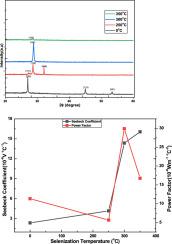Correlation of Seebeck coefficient and selenization temperature in CuSe thin films grown on glass substrate
IF 4.3
3区 材料科学
Q2 CHEMISTRY, MULTIDISCIPLINARY
引用次数: 0
Abstract
Copper selenide is emerging as a promising thermoelectric material that has the ability to harvest electricity from heat. In the present research work, copper selenide thin films were grown on glass substrate using thermal evaporation deposition technique. The phase transition from cubic to hexagonal structure was achieved by the selenization of grown samples at different temperatures (250, 300 and 350 °C) for 2 h. The phase, morphology and thermoelectric properties of the selenized CuSe thin films were studied using different characterization techniques. It was observed that the structural, morphological, and thermoelectric properties of the samples were modulated by varying the selenization temperature. XRD results suggested that as grown sample possessed a cubic phase but it transformed into hexagonal phase by selenization process. It was observed that Seebeck coefficient, electrical conductivity and power factor were modulated with the selenization temperature with maximum value of power factor (3.0 × 10−5±0.5 W m−1C−2) was obtained at optimal selinization temperature.

玻璃基板上生长的硒化铜薄膜的塞贝克系数与硒化温度的相关性
硒化铜是一种前景广阔的热电材料,具有从热量中获取电能的能力。在本研究工作中,使用热蒸发沉积技术在玻璃基底上生长了硒化铜薄膜。通过在不同温度(250、300 和 350 ℃)下硒化 2 小时,实现了生长样品从立方结构到六方结构的相变。结果表明,样品的结构、形态和热电性能随着硒化温度的变化而变化。XRD 结果表明,生长的样品具有立方相,但在硒化过程中转变为六方相。据观察,塞贝克系数、电导率和功率因数随硒化温度的变化而变化,在最佳硒化温度下功率因数达到最大值(3.0 × 10-5±0.5 W m-1C-2)。
本文章由计算机程序翻译,如有差异,请以英文原文为准。
求助全文
约1分钟内获得全文
求助全文
来源期刊
CiteScore
7.80
自引率
2.50%
发文量
605
审稿时长
40 days
期刊介绍:
The Journal of Physics and Chemistry of Solids is a well-established international medium for publication of archival research in condensed matter and materials sciences. Areas of interest broadly include experimental and theoretical research on electronic, magnetic, spectroscopic and structural properties as well as the statistical mechanics and thermodynamics of materials. The focus is on gaining physical and chemical insight into the properties and potential applications of condensed matter systems.
Within the broad scope of the journal, beyond regular contributions, the editors have identified submissions in the following areas of physics and chemistry of solids to be of special current interest to the journal:
Low-dimensional systems
Exotic states of quantum electron matter including topological phases
Energy conversion and storage
Interfaces, nanoparticles and catalysts.

 求助内容:
求助内容: 应助结果提醒方式:
应助结果提醒方式:


